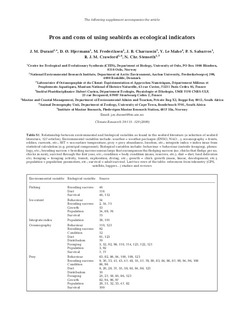Pros and cons of using seabirds as ecological indicators
| dc.contributor.author | Durant, Joël M. | |
| dc.contributor.author | Hjermann, Dag Ø. | |
| dc.contributor.author | Frederiksen, Morten | |
| dc.contributor.author | Charrassin, Jean-Benoit | |
| dc.contributor.author | Le Maho, Yvon | |
| dc.contributor.author | Sabarros, Philippe Sunil | |
| dc.contributor.author | Crawford, Robert J.M. | |
| dc.contributor.author | Stenseth, Nils Christian | |
| dc.date.accessioned | 2012-11-07T12:46:34Z | |
| dc.date.available | 2012-11-07T12:46:34Z | |
| dc.date.issued | 2009-07-14 | |
| dc.identifier.issn | 0936-577X | |
| dc.identifier.uri | http://hdl.handle.net/11250/109075 | |
| dc.description.abstract | Climate change and overfishing are increasingly causing unanticipated changes in marine ecosystems (e.g. shifts in species dominance). In order to understand and anticipate these changes, there is a crucial need for indicators that summarise large quantities of information into a few relevant and accessible signals. Seabirds have been suggested as good candidates for ecological indicators of the marine environment; however, few studies have critically evaluated their value as such. We review the role of seabirds as ecological indicators, and discuss their limitations and drawbacks, as compared to other types of indicators. In addition, we highlight the statistical consequences of inverse inference when using seabird data as indicators. We discuss the use of integrated indices and the use of seabirds as autonomous samplers of the marine environment. Finally, we highlight the necessary steps preceding the use of seabirds as indicators. We conclude that, in order to use seabird time series properly, the use of recent advances both in statistics and in remote sensing is a way to move forward. This, along with the assessment of their usefulness, should enable us to use seabird indicators appropriately for managing urgent conservation problems. | no_NO |
| dc.language.iso | eng | no_NO |
| dc.publisher | Inter-Research | no_NO |
| dc.rights | open access | |
| dc.subject | marine ecosystems | no_NO |
| dc.subject | marine økosystemer | no_NO |
| dc.subject | seabirds | no_NO |
| dc.subject | sjøfugl | no_NO |
| dc.subject | management advice | no_NO |
| dc.subject | forvaltningsråd | no_NO |
| dc.title | Pros and cons of using seabirds as ecological indicators | no_NO |
| dc.type | Journal article | no_NO |
| dc.type | Peer reviewed | no_NO |
| dc.subject.nsi | VDP::Agriculture and fishery disciplines: 900::Fisheries science: 920::Resource biology: 921 | no_NO |
| dc.subject.nsi | VDP::Mathematics and natural science: 400::Geosciences: 450::Oceanography: 452 | no_NO |
| dc.source.pagenumber | 115-129 | no_NO |
| dc.source.volume | 39 | no_NO |
| dc.source.journal | Climate Research | no_NO |
| dc.source.issue | 2 | no_NO |
| dc.identifier.doi | http://dx.doi.org/10.3354/cr00798 |
Tilhørende fil(er)
Denne innførselen finnes i følgende samling(er)
-
Articles [3012]
